新目标七年级英语下册Unit 5 I’m watching TV教案
新目标七年级下Unit5I'mwatchingTV教学设计
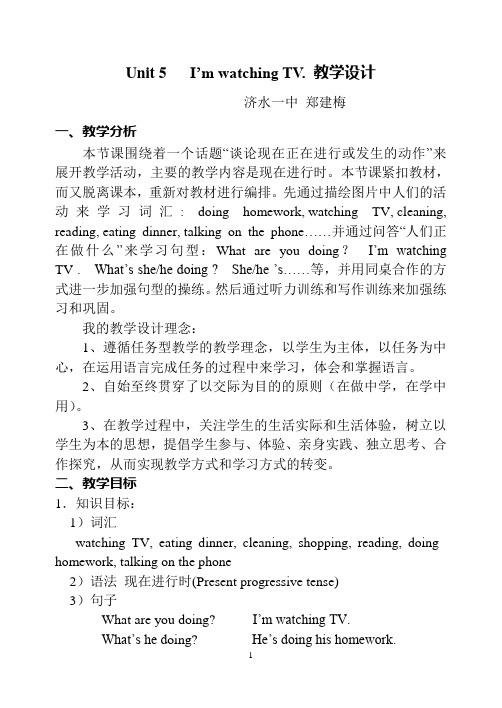
Unit 5 I’m watching TV.教学设计济水一中郑建梅一、教学分析本节课围绕着一个话题“谈论现在正在进行或发生的动作”来展开教学活动,主要的教学内容是现在进行时。
本节课紧扣教材,而又脱离课本,重新对教材进行编排。
先通过描绘图片中人们的活动来学习词汇: doing homework, watching TV, cleaning, reading, eating dinner, talking on the phone……并通过问答“人们正在做什么”来学习句型:What are you doing?I’m watching TV . What’s she/he doing ?She/he ’s……等,并用同桌合作的方式进一步加强句型的操练。
然后通过听力训练和写作训练来加强练习和巩固。
我的教学设计理念:1、遵循任务型教学的教学理念,以学生为主体,以任务为中心,在运用语言完成任务的过程中来学习,体会和掌握语言。
2、自始至终贯穿了以交际为目的的原则(在做中学,在学中用)。
3、在教学过程中,关注学生的生活实际和生活体验,树立以学生为本的思想,提倡学生参与、体验、亲身实践、独立思考、合作探究,从而实现教学方式和学习方式的转变。
二、教学目标1.知识目标:1)词汇watching TV, eating dinner, cleaning, shopping, reading, doing homework, talking on the phone2)语法现在进行时(Present progressive tense)3)句子What are you doing? I’m watching TV.What’s he d oing? He’s doing his homework.What are they doing? They’re cleaning the room.2. 能力目标:学会用英语谈论人们正在做什么(To freely talk about or learn about what they are doing) 3. 文化目标:培养用英语获取信息,与人合作的能力。
七年级英语Unit 5 I’m watching TV人教新目标版知识精讲
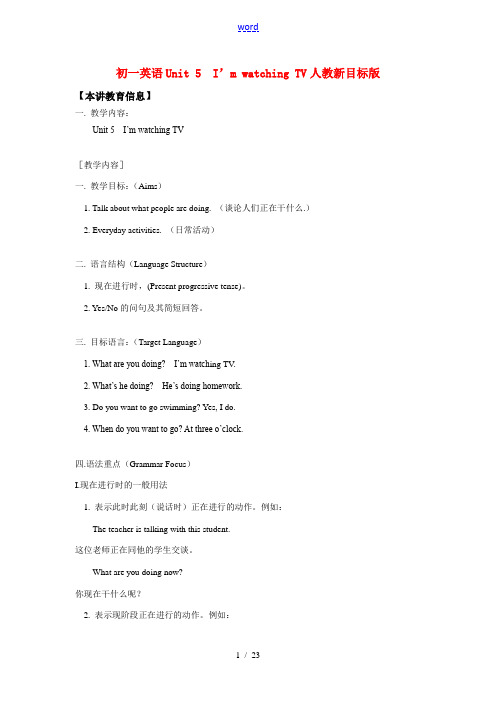
初一英语Unit 5 I’m watching TV人教新目标版【本讲教育信息】一. 教学内容:Unit 5 I’m watching TV[教学内容]一. 教学目标:(Aims)1. Talk about what people are doing. (谈论人们正在干什么.)2. Everyday activities. (日常活动)二. 语言结构(Language Structure)1. 现在进行时,(Present progressive tense)。
2. Yes/No的问句及其简短回答。
三. 目标语言:(Target Language)1. What are you doing? I’m watch ing TV.2. What’s he doing? He’s doing homework.3. Do you want to go swimming? Yes, I do.4. When do you want to go? At three o’clock.四.语法重点(Grammar Focus)I.现在进行时的一般用法1. 表示此时此刻(说话时)正在进行的动作。
例如:The teacher is talking with this student.这位老师正在同他的学生交谈。
What are you doing now?你现在干什么呢?2. 表示现阶段正在进行的动作。
例如:We are doing an experiment this week.我们本星期在做一个实验。
3. 现在进行时有时可用来表示将来发生的动作。
这一用法常用于go, e, leave, start等动词(大部分是短暂性动词),后面也常用表示较近的将来时间状语(如tomorrow, tonight, this morning/ Friday等),表示安排或计划好的事情。
例如:We are leaving for Shanghai tomorrow.我们明天启程去某某。
七年级下册-unit-5-I'm-watching-TV.英文版说课稿
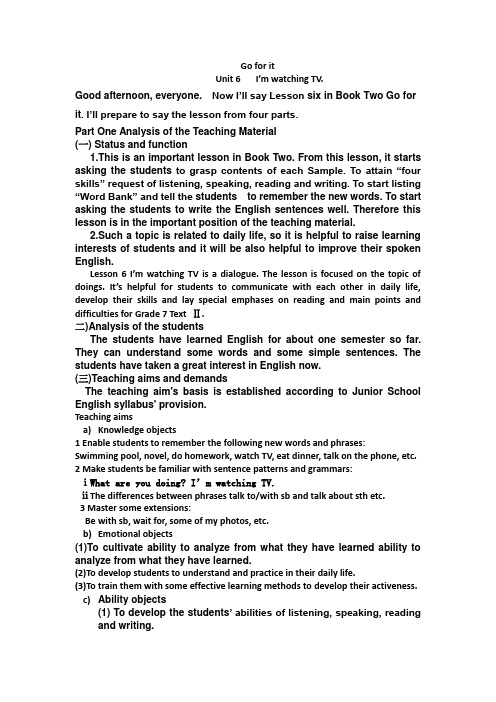
Go for itUnit 6 I’m watching TV.Good afternoon, everyone. Now I’ll say Lesson six in Book Two Go for it. I’ll prepare to say the lesson from four parts.Part One Analysis of the Teaching Material(一) Status and function1.This is an important lesson in Book Two. From this lesson, it starts asking the students to grasp contents of each Sample. To attain “four skills” request of listening, speaking, reading and writing. To start listing “Word Bank” and tell the students to remember the new words. To start asking the students to write the English sentences well. Therefore this lesson is in the important position of the teaching material.2.Such a topic is related to daily life, so it is helpful to raise learning interests of students and it will be also helpful to improve their spoken English.Lesson 6 I’m watching TV is a dialogue. The lesson is focused on the topic of doings. It’s helpful for students to communicate with each other in daily life, develop their skills and lay special emphases on reading and main points and difficulties for Grade 7 Text Ⅱ.二)Analysis of the studentsThe students have learned English for about one semester so far. They can understand some words and some simple sentences. The students have taken a great interest in English now.(三)Teaching aims and demandsThe teaching aim's basis is established according to Junior School English syllabus' provision.Teaching aimsa)Knowledge objects1 Enable students to remember the following new words and phrases: Swimming pool, novel, do homework, watch TV, eat dinner, talk on the phone, etc.2 Make students be familiar with sentence patterns and grammars:ⅰWhat are you doing? I’m watching TV.ⅱThe differences between phrases talk to/with sb and talk about sth etc.3 Master some extensions:Be with sb, wait for, some of my photos, etc.b)Emotional objects(1)To cultivate ability to analyze from what they have learned ability to analyze from what they have learned.(2)To develop students to understand and practice in their daily life.(3)To train them with some effective learning methods to develop their activeness.c)Ability objects(1) To develop the students’ abilities of listening, speaking, readingand writing.(2) To train the students’ abi lity of working in pairs.(3) To develop the students’ abilities of communication by learningthe useful sentences.Teaching main pointsa New words and phrases: cinema, swimming pool, do homework etc.b The present Progressive ( Be + V-ing )c Improve their reading skills and reciting ability.Teaching difficultiesThe differences : a say, speak, tell, talkb a little littlea few fewTeaching method: Task-based methodTeaching aids: multi-media photos blackboardTeaching procedures:Step 1 Usual greeting!Step 2 Leading-in: show some pictures of doing homework, watching TV etc before beginnging our class. Then teacher draw conclusions. Step 3 Presention:a This activity provides this activity provides oral practice using the target language.1.Do the first half of the activity orally with the students, by focusing attention onthe pictures one at a time, and asking the class the questions under the pictures.2.Then have the students work in pairs. They cover the questions and take turnsto explain what’s happening in each picture.Walk around the class offering language support where necessary.b an acting game : to imitate actions according to pictures.Step 4 Conclusion: difficulties , sentences and some extensions:a talk to/with +somebody: to communicate with sb +whotalk about +something :to say something +whatb What are you doing? I’m watching TV.What is she/he doing? She/He is going to see the movies.C a little littlea few fewd say +contentsspeak +languagetell+sb etctalk+to/with sbtalk +about sthStep 5 HomeworkMake up a dialogue to apply to the grammars and sentences.Blackboard designingUnit 6 I’m watching TVDoing homework What are you doing? Extension:Watching TV I’m watching TV. Talk toCleaning What is she/he doing? Talk about Eating dinner She/He is doing homework. Be with Reading a novelTalking on a phone。
新目标七年级下Unit5 I'm watching TV(SectionA 1a--1c)教学中的互联网搜索教案设计
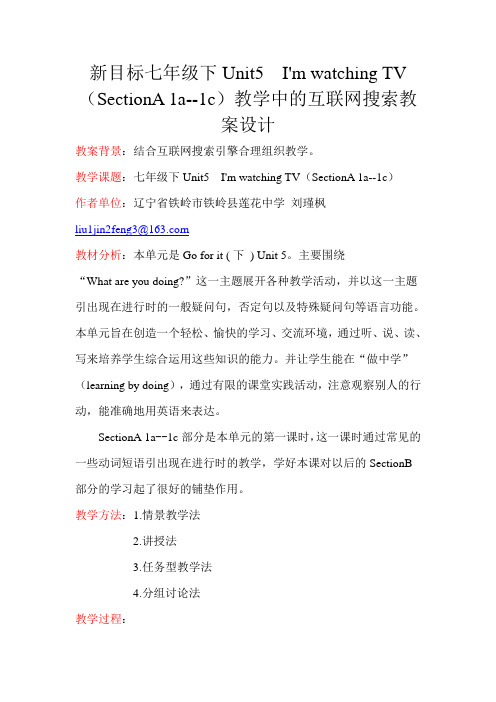
新目标七年级下Unit5 I'm watching TV (SectionA 1a--1c)教学中的互联网搜索教案设计教案背景:结合互联网搜索引擎合理组织教学。
教学课题:七年级下Unit5 I'm watching TV(SectionA 1a--1c)作者单位:辽宁省铁岭市铁岭县莲花中学刘瑾枫liu1jin2feng3@教材分析:本单元是Go for it ( 下 ) Unit 5。
主要围绕“What are you doing?”这一主题展开各种教学活动,并以这一主题引出现在进行时的一般疑问句,否定句以及特殊疑问句等语言功能。
本单元旨在创造一个轻松、愉快的学习、交流环境,通过听、说、读、写来培养学生综合运用这些知识的能力。
并让学生能在“做中学”(learning by doing),通过有限的课堂实践活动,注意观察别人的行动,能准确地用英语来表达。
SectionA 1a--1c部分是本单元的第一课时,这一课时通过常见的一些动词短语引出现在进行时的教学,学好本课对以后的SectionB部分的学习起了很好的铺垫作用。
教学方法:1.情景教学法2.讲授法3.任务型教学法4.分组讨论法教学过程:1.知识与技能(即语言)目标用英语谈论正在做什么What are you doing? I'm doing...What is he/she doing? He/She's doing...2.过程与方法1)运用肢体语言2)强调视觉作用3)运用合作学习(pairwork)3. 情感态度通过对本单元的任务性活动,我的目的是能培养培养学生学习英语的强烈兴趣,乐于参加各种活动的积极情感,乐于合作,培养学生团结合作的精神。
Step 1. GreetingT: Class begins.Ss: Good afternoon, Miss Qiu.T: Good afternoon, boys and girls.T: I want to know something about you. Who can answer my questions? T: What is your name? (Ask one student.)S1:My name is ….T: What’s the weather like today?S1:It is ….T: When is your birthday?S1:It’s …T: I want to have a birthday party for you .Would you like to join u s?Ss: Yes , we’d love to.(通过师生对话,使学生在轻松自然的环境中学习,调动学习的积极性。
新人教新目标版英语七年级下册《unit 5 i’m watching tv》优秀教案(重点资料).doc

. Unit5 Section A (1a-2c ) 教案微山县西平一中张善斌Teaching aimsKnowledge:Learn the Present Progressive Tense and some new words. Ability: Listening, speaking and writing skills and Communicative competence.Moral education: the ability to cooperate and deal with the difficulties.Key points: What are you doing? I’m watching TV.Is Nancy doing homework? No, she isn’t She’s writing a letter.Difficult points: the rules of v-ing and the use of the Present Progressive Tense, especially the questions and “Yes/ No ”answers.Teaching methods: Task basedTeaching proceduresStep7 : Do some exercises:一、选择填空:1. What are you doing? I_____A. eatB. can eatC. eatingD. am eating2. We want _________this book now.A. readingB. am readingC. readD. to read3. It’s eight o’clock. Jim’s family _____TV.A. is watchingB. are watchingC. watchD. to watch4. That boy isn’t ____the teacher .A. listenB. listensC. listeningD. listening to5. __ you __ the window? —Yes, I am.A. Do, cleanB. Is, cleaningC. Are, cleaningD. Do, cleaning二、动词填空1.He__ _____ (do) his homework now.2.Look! That girl __ ____ (ride) the bike.3.Tom and I ___ ________(clean) our bedroom now.4.My mother and I ____ _______(make) cakes now.5. Listen! The twins ___ _______(sing) under the tree.三、Writing: 描述Bob一家人正在干什么?Father motherGrandfatherBobgrandmotherNancy。
英语人教版Unit5《I’mwatchingTV》教案(七年级下)

Unit 5 I’m watching TV.(section B)ⅠTeaching Aims and Demands1.Knowledge ObjectsWhere do people play basketball?At school.Hello! Is Tina there?No, she isn’t.Some words of places and activities.Open-ended oral practice.2.Ability ObjectTrain students’ listening, speaking, reading and writing skills.Train students’ communicative competence.Self-check.3.Moral ObjectTo be interested in many things.Love our school and take care of everything in our school. Ⅱ. Teaching Key PointsWords of places and activities.Key vocabularyⅢ. Teaching Difficultieshello! Is Tina there?No, she isn’t.Open-ended oral practice.Use some words to complete a story.Ⅳ. Teaching MethodsListening, reading, writing and speaking methods.PairworkPracticing methodsGroup workDescribing methodsⅤ. Teaching AidsA computerCardsⅥ. Teaching ProceduresStepⅠGreetingGreet the class as usual.Check the homework.StepⅡ 1a 1b1. Ask a student to read the words to the class. Then have them say which are places andwhich are activities.2. Then let students complete the chart.3. Check the answers.4. Pairwork. Ask and answer questions with a partner. Make questions and answers likethe ones in the picture.StepⅢ 2a 2b1. You will hear three conversations, write the places you hear on the recording in thechart below.2. Play the recording two times.3. Then check the answers.4. Listen to the recording again. Write an activity for each person on the chart.StepⅣ An activityWhat do you really want to do?Challenge more able students to expand the range of activities they can talk about.StepⅤ 2c PairworkAsk several pairs of students to present their conversations to the class.StepⅥ3a 3b1. Underline the activities and circle the places.2. Read the letter one more time. Number of the photographs is the order they read aboutthem in the letter.3. Complete the letter to Bob according to the picture.StepⅦ 3c1. Ask students to bring in some family photos or some pictures of their family or friends.2. Ask students to write similar sentences about their own pictures.StepⅧ 4 Group workAsk students to share their pictures and write with other students sitting near them.StepⅨ Self-check 1 2 31. Check all the words they have know.2. Ask students to enter five new words in their Vocab-builder.3. Encourage the students to say something about the pictures before the class.StepⅩ Just for fun!Ask all students to read the conversation. This activity provides reading practice with the target language.StepⅪ SummaryThis class we’ve reviewed all key vocabularies presented in this unit and the target language.StepⅫ HomeworkPractice the language presented in this unit.Blackboard Design。
新目标七年级英语下册Unit 5 I’m watching TV教案
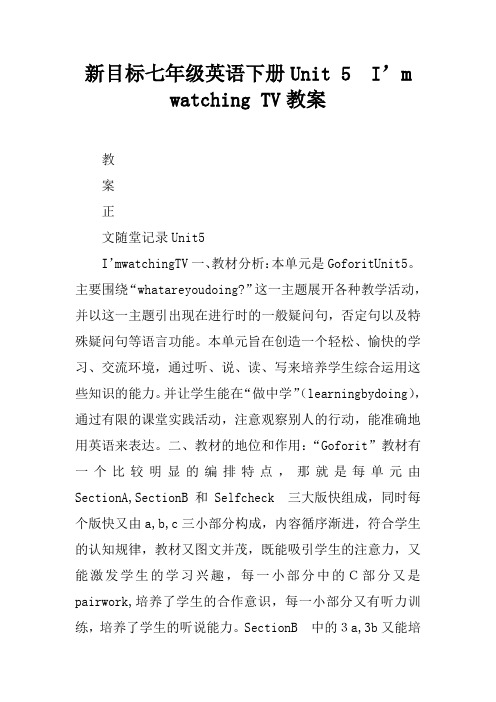
新目标七年级英语下册Unit 5 I’mwatching TV教案教案正文随堂记录Unit5I’mwatchingTV一、教材分析:本单元是GoforitUnit5。
主要围绕“whatareyoudoing?”这一主题展开各种教学活动,并以这一主题引出现在进行时的一般疑问句,否定句以及特殊疑问句等语言功能。
本单元旨在创造一个轻松、愉快的学习、交流环境,通过听、说、读、写来培养学生综合运用这些知识的能力。
并让学生能在“做中学”(learningbydoing),通过有限的课堂实践活动,注意观察别人的行动,能准确地用英语来表达。
二、教材的地位和作用:“Goforit”教材有一个比较明显的编排特点,那就是每单元由SectionA,SectionB和Selfcheck 三大版快组成,同时每个版快又由a,b,c三小部分构成,内容循序渐进,符合学生的认知规律,教材又图文并茂,既能吸引学生的注意力,又能激发学生的学习兴趣,每一小部分中的C部分又是pairwork,培养了学生的合作意识,每一小部分又有听力训练,培养了学生的听说能力。
SectionB 中的3a,3b又能培养学生的读写能力,本单元的综合语言知识能力的运用,又能在此体现出来。
SectionB中的3c是任务性教学,体现了语言的交际性和实用性。
1.语言知识:本单元要求学生掌握以下词汇(phone,mall,movies,sound,show,boring,library,socce r.watchTV,dohomework,eatingdinner,talkingonthephone )2.语言功能:学会读、写一篇有关人们正在运动的短文。
3.语言结构(日常交际用语):whatareyou/theydoing?I'm/we're/They'rewatchingTV.Is he/shewatchingTV?yes,he/sheis./No,he/sheisn't.2.语言技能:(1)能用现在进行时的各种形式进行准确的描述和表达正在发生的动作。
新目标 七年级下《 Unit 5 I am watching TV 》 临江市第四中学 王凯谋
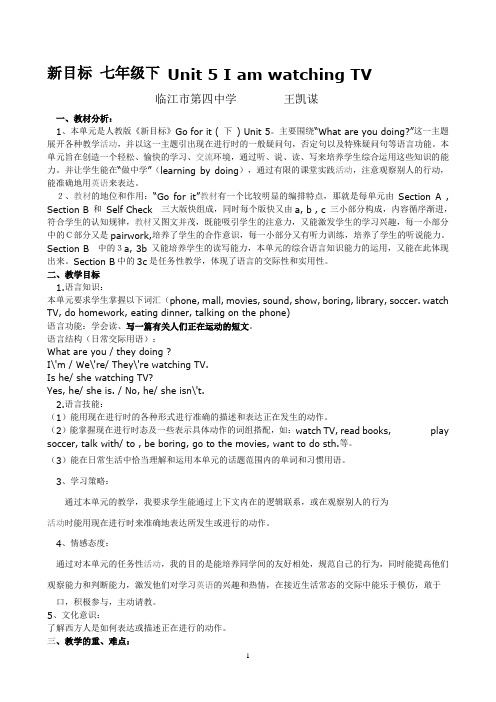
新目标七年级下Unit 5 I am watching TV临江市第四中学王凯谋一、教材分析:1、本单元是人教版《新目标》Go for it ( 下) Unit 5。
主要围绕“What are you doing?”这一主题展开各种教学活动,并以这一主题引出现在进行时的一般疑问句,否定句以及特殊疑问句等语言功能。
本单元旨在创造一个轻松、愉快的学习、交流环境,通过听、说、读、写来培养学生综合运用这些知识的能力。
并让学生能在“做中学”(learning by doing),通过有限的课堂实践活动,注意观察别人的行动,能准确地用英语来表达。
2、教材的地位和作用:“Go for it”教材有一个比较明显的编排特点,那就是每单元由Section A , Section B 和Self Check三大版快组成,同时每个版快又由a, b , c 三小部分构成,内容循序渐进,符合学生的认知规律,教材又图文并茂,既能吸引学生的注意力,又能激发学生的学习兴趣,每一小部分中的C部分又是pairwork,培养了学生的合作意识,每一小部分又有听力训练,培养了学生的听说能力。
Section B中的3a, 3b 又能培养学生的读写能力,本单元的综合语言知识能力的运用,又能在此体现出来。
Section B中的3c是任务性教学,体现了语言的交际性和实用性。
二、教学目标1.语言知识:本单元要求学生掌握以下词汇(phone, mall, movies, sound, show, boring, library, soccer. watch TV, do homework, eating dinner, talking on the phone)语言功能:学会读、写一篇有关人们正在运动的短文。
语言结构(日常交际用语):What are you / they doing ?I\'m / We\'re/ They\'re watching TV.Is he/ she watching TV?Yes, he/ she is. / No, he/ she isn\'t.2.语言技能:(1)能用现在进行时的各种形式进行准确的描述和表达正在发生的动作。
七年级下册Unit 5《I'm watching TV》教案
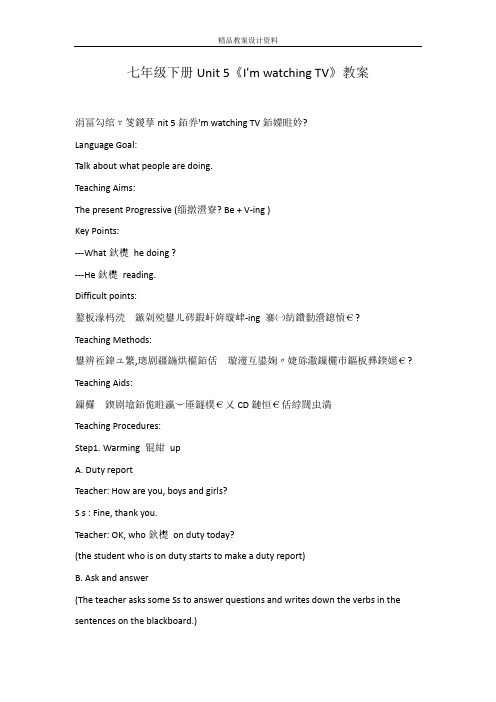
七年级下册Unit 5《I'm watching TV》教案涓冨勾绾т笅鍐孶nit 5銆奍'm watching TV銆嬫暀妗?Language Goal:Talk about what people are doing.Teaching Aims:The present Progressive (缁撴瀯寮? Be + V-ing )Key Points:---What鈥檚he doing ?---He鈥檚reading.Difficult points:-ing 褰㈠紡鐨勬瀯鎴愩€?Teaching Methods:鐢辨祬鍏ユ繁,? Teaching Aids:CD鏈恒€佸綍闊虫満Teaching Procedures:Step1. Warming 锟紺upA. Duty reportTeacher: How are you, boys and girls?S s : Fine, thank you.Teacher: OK, who鈥檚on duty today?(the student who is on duty starts to make a duty report)B. Ask and answer(The teacher asks some Ss to answer questions and writes down the verbs in the sentences on the blackboard.)T: Usually, what time do you go to school?S1: 鈥︹€?T: When does your father watch TV in the evening?S2: 鈥︹€?T: Do you do your homework in the evening?S3: 鈥︹€?T: When do you play soccer?S4: 鈥︹€?T: what time do you usually eat dinner?S5: 鈥︹€?(The teacher should encourage the students after questions.)The teacher ask the students to read these five verbs for several times.Step 2. PresentationA. Match the words and the activities.Ask the students to turn to page 83, and look at the pictures in 1a.Then,the teacher ask questions:----What鈥檚he doing? (Picture 1)----He鈥檚making a telephone call.(Help the students answer the question with body language .)Ask and answer just like that, and finish 1a.(Ss can guess the meaning of doing homework, watching TV, cleaning, eating dinner and reading.)The Ss read these V-ing words after the teacher.B. Play the video.To make the Ss clear what they are learning in this class. Mr. Gong鈥檚words do give the teacher a big hand.(Write down the title of Unit 14 I鈥檓watching TV on the blackboard and ask the Ssto read it.)C. Teach the Present Progressive.1. IntroductionTell the Ss what the Present Progressive is. (ㄨ繘琛屾垨鍙戠敓鐨勫姩浣? 瀹冪殑琛ㄧ幇褰㈠紡涓築e Verbs + V-ing ---- 杩欎篃鍗充负瀹冪殑缁撴瀯寮?)2. Tell the differenceWrite down the V-ing forms by another lines of go, watch, do, play and eat on the blackboard. Ask the Ss to have a look and find the difference between them. For example: go and going, watch and watching, do and doing, etc. Then, ask the Ss to read them again.3. Listen to the tape.Let the Ss get ready to listen to the tape (paper and ball-point pen).Check the answer: 2 4 14. Activities.The teacher acts several actions and say :鈥漌hat am I doing?鈥? help Ss answer: 鈥滻鈥檓opening the door.鈥?(The other actions: look at someone, clean the window)Write down the three sentences on the blackboard, and ask the Ss to pay attention to the important words underlined:n What am I doing?n I鈥檓opening the door.n What am I doing?n I鈥檓looking at him.n What am I doing?n I鈥檓cleaning the window.5. Pairwork.Ask and answer questions about what people are doing in the picture.u What鈥檚he doing?u He鈥檚reading.The Ss can practice different sentences upon the verbs on the blackboard.6. Guessing game.The teacher prepare several pieces of paper and there are different actions on it. Ask a pair of Ss to act it out. (Each pair of Ss choose two pieces of paper and act.) (The Ss must like to do it, so the teacher can ask many pairs to do this game and, the Ss can be familiar with the Present Progressive step by step. They can have fun in the classroom during this class, it鈥檚the most important.)7. Self-assessment.The teacher prepare for the Ss some listening exercises, and play the cassette, let them finish these exercises at once. Then, check the answer. The Ss can understand whether they have learned about the Present Progressive.8. Do the exercises.The teacher have the Ss some exercises, and ask the Ss to do at once.<1>--What鈥檚Li Lei doing?-- He_____________. ( read )<2>--What鈥檚his mother doing?--She_____________. ( write )<3>--What are they doing?--They_____________. ( play soccer)<4>--What are David and Mary doing?--They_____________. (have dinner)<5>--What鈥檚Jenny doing?--She______________. ( run )(In fact, the Ss don鈥檛have enough time to finish the exercises, so they can go on and finish these exercises after class.Step 3. Homework1. Finish the exercises in the class.2. Make a conversation and act it out with your partner. Step 4. The endT: You are very good today, boys and girls! And thank you for listening. Bye.。
人教新目标版英语七下《unit 5 i’m watching tv》word教案

人教新目标版英语七下《unit 5 i’m watchingtv》word教案Period OneTeaching ProceduresStep 1.Revision1.Greetings.2. Revise the words and expressions in Unit 4.Step 2.Presatation: Lead in1.Do “Ask and answer”practice with the Ss.2.The teacher asks the students to give more verbs phrases and write them down on the blackboard.(show many pictures to help the Ss.)Teach the new words and expressions.3. Teach the Present Progressive.1).Introduction: Talk about the title of this unit. Show some pictures to introduce the Present Progressive tense.T: What’s she/he doing? Ss: She/He is v-ing (Help the Ss to an swer the questions and show the sentences)2) Let the Ss to say what the Present Progressive is.(现在进行时表示现在正在进行或发生的动作, 它的表现形式为:Be V erbs + V-ing ….)Write down the V-ing forms by another lines of go, watch, do, play and eat . Ask the Ss to have a look and find the difference between the m. For example: go and going, watch and watching, do and doing, etc. T hen ask the Ss to read them again and do more exercises.Step3.Activity 1a:Match1.Help the Ss talk about the pictures. The Ss read these V-ing w ordsafter the teacher. Match the words and the activities. Check the answ ers.2.Help the Ss do “Ask and answer”practice in pairs.3.Ask some Ss to do actions and let the class guess what he/she is doingStep4.Activity 1b & 1c: Listening and pair work.1. Play the recording for the Ss to listen. Play again. Ss listen and write the number of the activity each person is doing. Check the answers.2. Pairwork: Ask the Ss to do “Ask and answer”practice about the picture in pairs. Some pairs present their dialogues to the class.Step 5.Activity 2a & 2b: Listening and Practi ce.1.Activity 2a:Talk about the picture in 2b.Ask the Ss to read the que stions in 2a. Then listen to the tape and and write the answers. Check the answers.2.Activity 2b:Play the recording again. Help the Ss put these question s and answers in order to make a conversation. Go through the answers with the Ss.Step 6 Pairwork: Activity 2c1.Talk about the pictures in 2c. Ask Ss to read the sample conversati on. Let Ss look at the first group of pictures, and ask them to guess wha t the people are doing2. Then imitate the sample conversation, work in pairs. Some pairs p resent their dialogues to the class.3. A guessing game: Guess the activities according to the Ss’action s.Step 7 Grammar focusGo through the sentences with the Ss. Deal with some language poin ts.Step 8 Homework: 1.Copy the new words and recite.2.Make up their own dialoguesPeriod TwoStep 1.Revision1.Greetings.2.Revise the v-ing forms of verbs. Ask students to do some Exx.read-reading,watch-watching,enjoy-enjoying,sleep-sleeping,visit-visiting have-having, write-writing,t ake-taking, run-running, swim--- swimmin g,3.Play a game to revise the Present progressive tense :Ask some Ss t o the front and act out some activities, guess what she/he is doing.Step 2. Presentation:1.Present the target sentences:T: What am I doing? Ss: You’re reading.T: Where am I reading? Ss: You’re reading in the classroom.2.Activity 3a:talk about the pictures with the Ss. Using“What’s he/ she doing?”“He’s/She’s….”Step 3.Activity 3a/3b:1. Activity 3a :Match the conversations with the pictures, and one pi cture has no conversation. Check the answers.2.Read through the concersations, deal with any language points. The n read the conversations together]3.Activity 3b:Help the Ss make a new conversation. Then ask some pairs to come to the front and present to the classStep 4 .Activity 4:Pair work.1. Look at the four pictures in Activity 4.Talk about the pictures w ith the Ss.Make sure the Ss know clearly about the pictures.2.Help the Ss answer the questions under the pictures.Check their ans wers.Step5.Play guessing games:Write some words about actions on small pieces of paper. Give them to some Ss .Let other Ss guess the activities according to the Ss’actio ns.Step6 Homework:Write their new conversation made in this lesson.英语七年级下人教新课标Unit5教案二Period ThreeStep 1.Revision1.Greetings.2. Review:Show the Ss some pictures and revise Present progressive tense.Step 2 Prsentation,K]Show the Ss a picture about a man watching TV at home.Ask the S s:Is he watching TV?(Yes,he is.)Where is he watching TV?(At home) Let Ss look at the pictures in Activity 1a and teach the new words.Step 3.Activity 1a & 1b:Writing and Practice.1. Activity 1a: Let students complete the chart. Check the answers.2.Activity 1b:Pairwork. Ask and answer questions with a partner. Ma ke questions and answers like the ones in the picture.Then practice in pai rs.3. Ask some pairs to present their conversations to the class.Step 4. Activity 2a & 2b:Listening1. Activity 2a:Listen to the conversation and complete the chart.2. Activity 2b:Listen again. Write the activities in the chart.Check the Ss’answers.Get the Ss do “Ask and answer”practice i n pairs,using“Where is Tina…?”“What’s he/she doing?”Step 5.Activity 2c:Pair workHelp the Ss use the information in the chart to make a new con versation in pairs. Practise ,then ask some pairs to present their conversati onsin front .Step 6. Selfcheck 1: Review the key vocabulary1. Ask students to check all the words they know.Give them two mi nutes to memorize the key words. Review the structures in this unit.2. Then have a dictation.3.Ask Ss to write five new words in their V ocab-builder on page 30.Step 7. HomeworkWrite five sentences using Present progressive tense.Period FourStep 1.Revision1.Greetings.2.Show some pictures. Revise some places and activities.Ask the Ss :Where is he/she?What’s he/she doing?Step2.PreasentationFirst,T talks about a photo of his family.Then talk about the pict ures in Activity 3a.Make sure the Ss know wha t the children are doing i n each picture.Step3.Activity 3a & 3b:Reading1. Activity 3a :Give the Ss some time to read the letter by themselv es. Number the pictures according to the order they read about them in t he letter. Listen and find out the activities and places.Un derline the activit ies and circle the places. Check the answers.Deal with any difficult langu age points.Read the letter with the Ss.2. Activity 3b: Fill in the blanks in Activity 3b according to the pict ure. Deal with any difficult language points.Read the letter with the Ss.Step4.Activity 3c & 4: Speaking & Writing.1. Activity 3c: Ask students to bring in some family photos or so me pictures of their family or friends.Help the Ss write similar sentences about their own pictures.Ask some Ss to read out their passages to the cl ass2. Activity 4:Groupwork.Put students into groups of four. Ask them to share their pictures in groups and do“Ask and answer”practice.Step5.Self-check 3.1. Self-check 3:Talk about the pictures in this part.Help the Ss ask q uestions about each picture,then discuss the answers together.Check the an swers.Teach the new words:camera,bird.Step 6 Just for fun!Look at the cartoon pictures and read the conversation.Step Homework:1.Revise the whole unit2.Write a letter to sb: write something about your family photo.英语七年级下人教新课标Unit5教案三一、教学分析本节课围绕着一个话题“谈论现在正在进行或发生的动作”来展开教学活动,要紧的教学内容是现在进行时。
七年级新目标英语(下册)Unit 5 I’m watching TV 教学设计
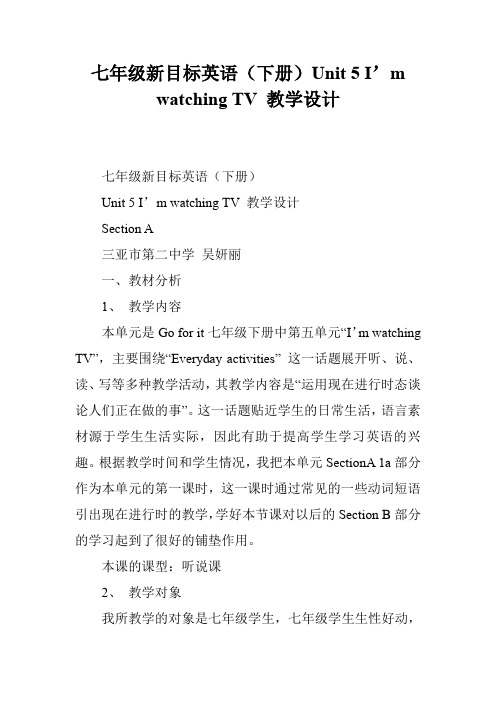
七年级新目标英语(下册)Unit 5 I’mwatching TV 教学设计七年级新目标英语(下册)Unit 5 I’m watching TV 教学设计Section A三亚市第二中学吴妍丽一、教材分析1、教学内容本单元是Go for it七年级下册中第五单元“I’m watching TV”,主要围绕“Everyday activities” 这一话题展开听、说、读、写等多种教学活动,其教学内容是“运用现在进行时态谈论人们正在做的事”。
这一话题贴近学生的日常生活,语言素材源于学生生活实际,因此有助于提高学生学习英语的兴趣。
根据教学时间和学生情况,我把本单元SectionA 1a部分作为本单元的第一课时,这一课时通过常见的一些动词短语引出现在进行时的教学,学好本节课对以后的Section B部分的学习起到了很好的铺垫作用。
本课的课型:听说课2、教学对象我所教学的对象是七年级学生,七年级学生生性好动,好奇心强,求知欲旺盛,但他们对学习英语既感到好奇又担忧,这需要老师正确引导。
因此,我在教学活动中尽量让他们参与到活动中来,努力激励他们大胆开口,通过学生之间合作学习,降低他们的学习难度,使他们体验到成功的喜悦。
3、教学方法及媒体本课采用任务型教学法以及运用多种教学方法和手段,充分调动学生的积极性,同时借助多媒体辅助教学。
4、教学目标(1)知识目标①短语和单词:doing homework, watching TV, cleaning, eating dinner, reading,talking on the phone, apartment.②句型结构:—What are you doing? —I’m watching TV—What’s he / she doing? —He’s / She’s reading.—What are they doing? —They’re watching TV.—Is he reading? —No, he is watching TV.(2)能力目标学会谈论人们正在做什么及掌握现在进行时的问答。
英语人教版Unit5《I’mwatchingTV》教案3(七年级下)
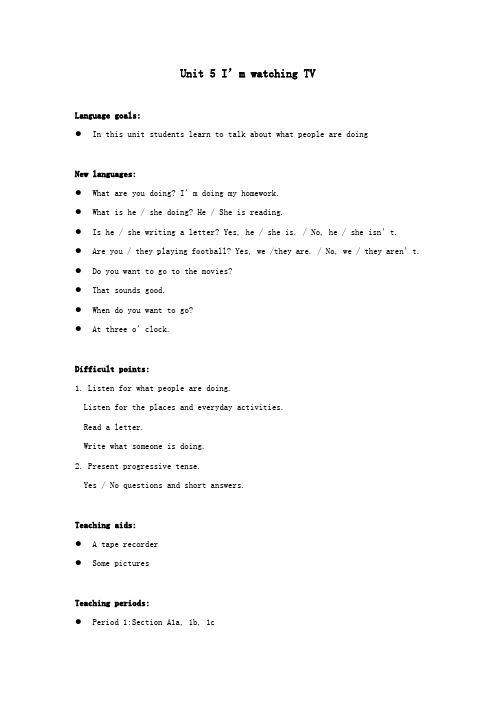
Unit 5 I’m watching TVLanguage goals:●In this unit students learn to talk about what people are doingNew languages:●What are you doing? I’m doing my homework.●What is he / she doing? He / She is reading.●Is he / she writing a letter? Yes, he / she is. / No, he / she isn’t.●Are you / they playing football? Yes, we /they are. / No, we / they aren’t.●Do you want to go to the movies?●That sounds good.●When do you want to go?●At three o’clock.Difficult points:1. Listen for what people are doing.Listen for the places and everyday activities.Read a letter.Write what someone is doing.2. Present progressive tense.Yes / No questions and short answers.Teaching aids:● A tape recorder●Some picturesTeaching periods:●Period 1:Section A1a, 1b, 1c●Period 2:Section A2a, 2b, 2c●Period 3:Section A3a, 3b, 4●Period 4:Section B 1a, 1b, 1c, 2a,2b, 2c●Period 5:SectionB 3a, 3b, 3c, 4●Period 6:Self CheckPeriod 1Teaching aims:1. Teach vocabulary words.2. Target languages:What are you doing?I’m watching TV.What is he doing?He’s reading.3. Enable the students to talk about what people are doing.4. Help the student learn how to listen to and talk about what people are doing.Teaching procedures:Step 1. Warming up and lead-inPerform some actions and make sentences.Say: Hello, boys and girls. Nice to see you here again.Today we’re going to learn Unit 5. We are going to talk about everyday activities.And now I'll act out some activities and you can guess what I’m doing.Ask the students to repeat the two sentences several times.Open a book and read it.Ask some students to do some simple actions and ask them the questions.Say: I will ask some students to do some simple actions and tell me what you are doing.Step 2.Match work (1a)Ask the students to read the words and the picture, and then match the activities with the pictures a–f.Encourage or help the students to say something about the picture and do the match work.Line next to the words “watching TV.”(as shown below)Go on with the others in the same way. Then check the answers with the students.Step 3. Listening (1b)Ask the students to read the names in activity 1b and write the number from 1a.Play the recording. Let the students just listen.Then point out the blank lines where students will write numbers from 1a.Play the recording for a second time.Ask the students to listen to and read after the recording.Step 4. Pair work (1c)Ask the students to practice: Where is…doing?Show the following:—What’s he / she doing?—He / She is reading / cleaning / doing homework / watching TV / eating dinner / talking on the phone.Homework1. Ask the students to make conversations according to the model in 1c.2. Ask the students to learn the new words and expressions in this period.Period 2Teaching aims:1. Learn the vocabulary words and useful expressions.2. Target languages:Do you want to go to the movies?That sounds good. The TV show is boring.3. Enable the students to talk about what people are doing.4. Help the student learn how to listen to and talk about what people are doing.Teaching procedures:Step 1. RevisionCheck the homework. Ask some students to work in pairs and make conversations.Then ask some students to do actions and the others describe what he / she is doing.Ask a student to open the door.Ask a second student to write something on the blackboard.Do more activities and let the students answer the questions.Step 2. Listening (2a, 2b)Ask the students to read the two sentences in activity 2a. Then ask them to listen to the conversation and write the answers on the line.Check the answers in the following way.Ask the students to put the four sentences in activity 2b in order.Say: Now read the four sentences. They are in the wrong order. After reading you have to put them in good order. Then you can get a clear conversation. The first part of the conversation is “What are you doing?”Ask the students to listen and check their answers.Step 3. Pair work(2c)Ask three students to take turns doing an activity and others have to close their eyes.Ask questions when the first student is clean the board.Then go on with the second student who is writing on the blackboard.Call attention to the pictures in activity 2c.Say: Now look at the pictures in activity 2c. There are eight pictures here.The pictures show clearly what the students are doing. I give you three minutes to prepare.And then answer my questions.Ask them to work in pairs and take turns asking and answering questions.Ask the students to pay attention to the pictures again.Ask some pairs to present their dialogues in class.Step 4.Grammar focusAsk the students to read the sentences in the grammar box and sum up the sentence structure.Say: Now read aloud the sentences in the grammar box. Then write down the sentence structure in your exercise-books.Ask the students to pay attention to the bold type words in the above form and learn the following.HomeworkAsk the students to make conversations according to activity 2b.Period 3Teaching aims:1. Teach vocabulary words.2. Target languages:Sure, this video is boring.When do you want to go?Let’s go at six o’clock.3. Enable the students to talk about what people are doing.4. Help the students learn how to talk about what people are doing.Teaching procedures:Step 1. Warming upCheck the homework by asking some students to read the sentences.Ask the students to read the following passage and underline the sentences using the present continuous tense.Step 2. Reading and speaking (3a, 3b)Ask the students to finish Activity 3a.Then ask the students to make conversations.Ask some pairs to present their conversations in front.Step 3. Pair work (4)Ask the students to read the pictures in activity 4.Say: Look at the pictures. For each picture there are two questions under it. You have to answer the questions.Give the students a few minutes to prepare.The same goes with the other picture.Ask the students to work to cover the questions under each question. Work in pairs and ask and answer questions.Then ask some pairs to present their dialogues in front of the blackboard, looking at the pictures on the blackboard.HomeworkAsk the students to make conversations according to activity 3a.Period 4Teaching aims:1. Teach vocabulary words.2. Target languages:Where do people play basketball?At school.Hello! Is Tina there?No, she isn’t. She’s …3. Enable the students to talk about the places where activities take place.4. Help the students learn how to talk about the places where activities take place.Teaching procedures:Step 1. Warming upCheck the homework by asking some students to read the completed passage.Then show the following pictures and ask the students to describe the pictures using the present continuous tense.Step 2. Talk about the places where activities take place (1a)Ask the students to read the pictures.Say, Look at the six pictures. There are some words beneath each picture.I want a student to read the words aloud to the class.Ask the students to answer questions.Ask the students to do the match work.Check the answers in the following way.Say: Which of these words are places? And which of these words are activities?Which of the places will you go to, if you want to borrow books?Step 3. Pair work(1b)Ask the students to read the conversations in pairs.Then ask the students to work in pairs and make similar dialogues about the chart in activity 1b.Ask the students to practice: Where do people…?Step 4. Listening (2a and 2b)Ask the students to listen to the conversations.Say, Now let’s listen to the tape. We are going to hear three conversations.And you have to write the places and the activities you hear.Play the first conversation.Play the first conversation again. Then ask the students to write down where Tina is and what she is doing.Then go on with the other two conversations in the same way.Further activity: Ask the students to do some pair work in the following way if they can understand the listening material well.Then ask them to say the conversation without the help of the recording.Step 5. Pairwork (2b)Point out the example in the speech bubbles in 2c. Ask two students to read it.Then ask the students to work in pairs.HomeworkAsk the students to find some photos or draw some pictures of their own, their family or friends.Period 5Teaching aims:1. Teach vocabulary words.2. Target languages:Thanks for your letter and the photos.I’m playing basketball at school.He’s playing soccer.3. Enable the students to read and write about what people are doing.4. Help the students learn how to read and write about what people are doing.Teaching procedures:Step 1. RevisionAsk the students to pay attention to the pictures on page 28.Say, Look at the pictures in activity 1b on page 28. You have to work in pairs.One of you asks the questions and the other answers.Ask the other students to practice about the other pictures.Step 2. Reading (3a)Ask the students to talk about the pictures in 3a.Ask and answer questions about the second photo.And then ask some pairs to present their conversations to the class.Ask students to read the letter.Answer any questions students may have about the letter.Then ask the students to pay attention to the letter again.Check the answers.And then ask the students to listen to the recording of the letter and read after the tape.Step 3. Reading and writing (3b)Ask the students to pay attention to the picture in activity 3b.Say: Look at the picture, please. What are the people doing? Ask and answer questions in pairs.Ask some students to present their dialogues in class.Ask the students to read the letter.Ask the students to read the letter again and fill in the blanks.Step 4.Writing (3c)Draw a sample picture on the blackboard, in which some people are doing something.Say, Look at the picture. I want you to say something about the picture.Ask students to take out their photos or pictures.Ask some students to present their writing to the class.Step 5.Group work(4)Ask the students to read the conversation and the picture and the picture in 4.Say, Look at the picture in activity 4. There are some students in it. Who can tell me what they are doing?Ask them to share their pictures or photos.Say, Now show your pictures or photos to your classmates near you. Work in pairs.Ask and answer questions like the one in the picture in activity 4.HomeworkAsk the students to write another composition about one of their photos.Period 6Teaching aims:1. Teach vocabulary words.2. Enable the students to write something about some pictures.3. Help the students learn how to write a story by describing what happens in each picture.Teaching procedures:Step 1.Warming upShow some pictures to the students. Show the first picture in which some boys are playing football at school.Show the second picture in which a man is reading a newspaper at home.Give more chances to let them practice.Ask the students to show their photos or pictures.Step 2.Key word check(1)Ask the students to read all the words in this part.Say: Now read and check the words you know in 1 on page 30. Then make a sentence with each of them.Ask the students to check all the words they know.Ask the students to find out the meaning of any words you don’t know.Say: If there are any words you don’t know, you can look them up in your dictionary and ask me or ask for help from your classmates.Step 3.Vocab-Builder (2)Ask students to write five new words in their Vocabulary-Builder on page 112.Say, Open your books and turn to page 112, please write five new words in your Vocabulary-Builder. You can ask for help from your Chinese-English dictionary.After they are finished, ask two students to write their words down on the blackboard.And ask them to read the words and the whole class repeat.Step 4. Talking about the pictures (3)Ask the students to read the pictures.Say: Now look at the pictures in activity 3. What is happening in each picture?I want you to talk about the pictures. But I think you need some help. Lookat the blackboard.Move around the room, checking their progress and offering help if they need.And then ask some pairs to present their statements to the class.Homework1. Ask the students to summarize what they have learned in this unit.2. Ask the students to prepare for the next unit.。
- 1、下载文档前请自行甄别文档内容的完整性,平台不提供额外的编辑、内容补充、找答案等附加服务。
- 2、"仅部分预览"的文档,不可在线预览部分如存在完整性等问题,可反馈申请退款(可完整预览的文档不适用该条件!)。
- 3、如文档侵犯您的权益,请联系客服反馈,我们会尽快为您处理(人工客服工作时间:9:00-18:30)。
新目标七年级英语下册Unit I’athing TV教案教案正文随堂记录UnitI’athingTV一、教材分析:本单元是GfritUnit。
主要围绕“hatareuding?”这一主题展开各种教学活动,并以这一主题引出现在进行时的一般疑问句,否定句以及特殊疑问句等语言功能。
本单元旨在创造一个轻松、愉快的学习、交流环境,通过听、说、读、写来培养学生综合运用这些知识的能力。
并让学生能在“做中学”(learningbding),通过有限的堂实践活动,注意观察别人的行动,能准确地用英语来表达。
二、教材的地位和作用:“Gfrit”教材有一个比较明显的编排特点,那就是每单元由SetinA,SetinB和Selfhe 三大版快组成,同时每个版快又由a,b,三小部分构成,内容循序渐进,符合学生的认知规律,教材又图文并茂,既能吸引学生的注意力,又能激发学生的学习兴趣,每一小部分中的C部分又是pairr,培养了学生的合作意识,每一小部分又有听力训练,培养了学生的听说能力。
SetinB 中的3a,3b又能培养学生的读写能力,本单元的综合语言知识能力的运用,又能在此体现出来。
SetinB中的3是任务性教学,体现了语言的交际性和实用性。
1语言知识:本单元要求学生掌握以下词汇(phne,all,vies,sund,sh,bring,librar,serathTV,dher, eatingdinner,talingnthephne)2语言功能:学会读、写一篇有关人们正在运动的短文。
3语言结构(日常交际用语):hatareu/theding?I'/e're/The'reathingTVIshe/sheathin gTV?es,he/sheis/N,he/sheisn't2语言技能:(1)能用现在进行时的各种形式进行准确的描述和表达正在发生的动作。
(2)能掌握现在进行时态及一些表示具体动作的词组搭配,如:athTV,readbs,plaser,talith/t,bebring,gtthevies,anttdsth等。
(3)能在日常生活中恰当理解和运用本单元的话题范围内的单词和习惯用语。
3、学习策略:通过本单元的教学,我要求学生能通过上下文内在的逻辑联系,教案正文随堂记录和活动时能用现在进行时来准确地表达所发生或进行的动作。
4、情感态度:通过对本单元的任务性活动,我的目的是能培养同学间的友好相处,规范自己的行为,同时能提高他们的观察能力和判断能力,激发他们对学习英语的兴趣和热情,在接近生活常态的交际中能乐于模仿,敢于开口,积极参与,主动请教。
、文化意识:了解西方人是如何表达或描述正在进行的动作。
三、教学的重、难点:基于上述对教材的分析,我确定本单元的教学重点为词汇、词组搭配和现在进行时的用法。
教学难点为现在进行时中现在分词的结构及读音,能在交际中准确地运用现在进行时来描述或表达正在进行的动作。
四、教学方法1、教法分析:(1)现在进行时是学生刚刚接触的一种新的语法项目,而本单元的话题源自生活,立足这一点,我充分利用学生已有的知识和生活经验,创设生活化的真实情境(或半真实情境)引导学生在运用语言中学习语言,然后在学习新的语言知识后创造性地运用语言(为用而学,在用中学,学了就用)。
(2)开展多种类型的任务型活动,提供给学生合作交流的空间和时间,促使学生为完成任务和同学进行合作,为完成任务进行探究性学习。
2、学情分析:我们教学的对象是初一学生(以中等生为主),他们学习英语既感到好奇又担忧,希望能得到他人的肯定。
因此我在教学活动中尽量让他们参与到活动中来,有更多的机会来说英语,减少他们的恐惧感,通过学生间的合作学习,降低他们的学习难度,使他们体验到成功的喜悦。
同时在阅读和书面表达中加以落实,提高他们综合运用语言的能力,使各层次的学生都有所收获。
五、教学过程设计Perid neStep1aringup教案正文随堂记录接下来教师要求几个学生做一些动作,让其他学生用英语来猜测。
(目的是为本节的现在进行时作好铺垫)Step2Presentatin教师出示几张图片,引出现在进行时的结构和用法。
叫一位学生按照老师图片上的提示做动作,教师接着说:T:He/SheissingingnTheareplaingftballnT:hatishe/sheding?He/She'splaingftballn2)然后叫一个学生做动作,另一个学生问,进行问答练习。
S1:hatareudingn?S2:I'athingTVsing----singing/ath----athing/pla---plaing/et这样设计的目的是让学生在交际情景中感受出现在进行时的结构和用法。
Step3Pratie1Shsepituresandletthestudentsasandanseri npairseghatareuding?Iaeatinghatisheding?Heiseatinghataretheding?The'reeating2PratieSetinA3然后叫学生归纳出现在进行时的结构句型。
主语+a/is/are+动词的现在分词(培养学生归纳能力,找出记忆的规律。
)Step4Listening接下来的任务型听力要求学生对动作作出反应,教师可承接刚开始的话题,引导学生根据所学语言完成以下任务:1hatarethepepleding?2ritenubersfr1abel3hetheansersi npairsliethis:A:hatisennding?B:HeisathingTVA:hatareDaveandarding?B:TheareeatingdinnerA:hatishnding?B:HeisdingherHer:1熟记本的单词、词组和句型。
2完成Shelfhe33观察今晚自己一家人做的事。
Perid TStep1aringup1教师做几个动作,要求学生进行问答练习:hatistheteaherding?Sheisleaningthelassret2、然后三人活动,一人做动作,另两人进行问答练习。
hatishe/sheding?He/SheisplaingserIshe/Sheplaingftball?es,he/sheis/N,he/sheisn't(通过复习,使学生巩固上一节的主要内容,为本节进一步学习现在进行时打下基础。
)Step2Presentatin教师要求一位学生做打电话样子,然后问:hatishe/sheding?Iatalingnthephne教案正文随堂记录T:Duanttgtthevies?S:Sure/That'ssundsgdStep3Pratie1Assestudentstaeanversatinhatareuding?Duanttgtthevies?2Turntpage26,Setin2bPutthesequestinsandansersinrdertaeanversatinThenlistentthe tapearefullhetheansersStep3Listening要求学生听一段对话,然后回答一些问题。
检查学生的听力情况。
Step4Pratie1Shsepituresandasthestudentstaeanversatinabut thehatareuding?IareadingDuanttgtthevies?Surehenduanttg?Let'sgat7:002Turntbsatpage27Asthestudentstritethenu berfthepiturenextttherretnversatinStep1aringup教师出示几幅图片,要求学生进行问答练习。
如:hat'she/sheding?He/Sheisplaingbasetballhataretheding?TheareplaingftballIshe/shesiing?es,he/sheis/N,he/sheisn'tStep2Presentatin接着教师以前面复习的这几幅画,引入本的现在进行时的各种特教案正文随堂记录殊疑问句,如:herearetheplaingftball?hishe/shetalingt?etStep3Pratie教师在引入新的前提下,接下来提供以下任务,要求学生去完成。
(1)教师出示SetinB/1a中的六幅图片,要求学生用现在进行时的各种疑问句进行问答。
(2)要求学生在问答的基础上,完成SetinB/1a中的表格。
(本环节通过各种活动,目的是强化训练,加深印象,为运用将打下最坚实的基础。
)Step4Listening在上面环节的基础上,教师要求学生做以下的听力练习,根据听到的内容,完成下面的表格。
(SetinB/2b)(通过本次的听力练习,强化学生现在进行时的运用)StepPairr承接上部分听力内容,要求学生在模拟情景中进行交际,如:A:Hell,isTinathere?B:N,sheisn’tA:hereisshe?B:SheisatheA:hat’sshedingn?B:SheisathingTVA:Dessheanttgtthevies?B:SureLet'sgth ereat7:00Her:1熟记本节的重点句型2画一张或带一张家庭活动的照片PeridFurStep1aringup1教师出示几张图片,要求学生就图片中的内容进行问答hatishe/sheding?hereishe/sheplaingftball?hishe/sheplaingith?2然后要求学生就图片中的内容,用完整的句子进行介绍教案正文随堂记录Step2Reading1教师把刚才出示的图片顺序打乱,要求学生根据老师提供的具体内容,一个学生陈述,另一个学生重新排列图片的顺序2要求学生读ie写给他笔友的信,然后重新排列图片的顺序Step4Speaingandriting1在上述小组活动的基础上,再要求学生介绍自己照片的内容,目的是为下面的写作作好准备2要求学生完成一篇书信3同步写作:写一篇自己家照片的内容的书信体Her:1熟记本单元的单词,词组和重点句型2注意观察同学在间的活动,用现在进行时写一篇报道本单元我的教学设计理念:1、本单元的教学活动始终遵循任务型教学的教学理念,以学生为学习的主体,以任务为中心,在运用语言完成任务的过程中来学习,体会和掌握语言。
2、自始自终贯穿了以交际为目的的原则(在做中学,在学中用)。
3、在教学过程中,关注学生的生活实际和生活体验,让其贴近实际、贴近生活、贴近时代,树立以学生为本的思想,提倡学生参与、体验、亲身实践、独立思考、合作探究,从而实现教学方式和学习方式的转变。
